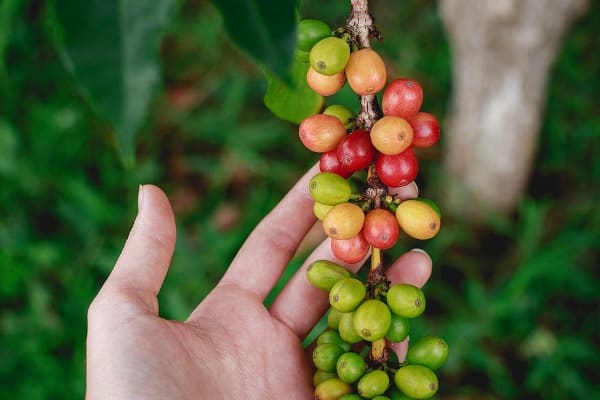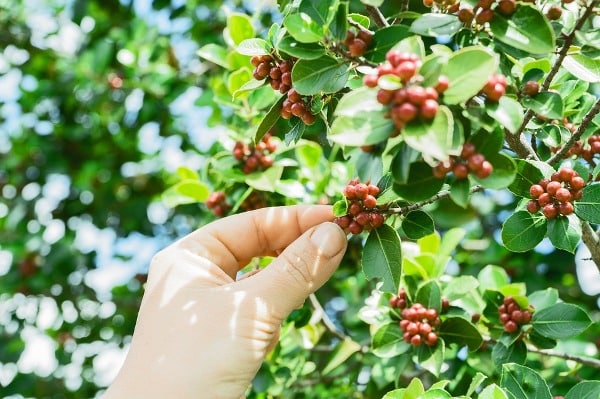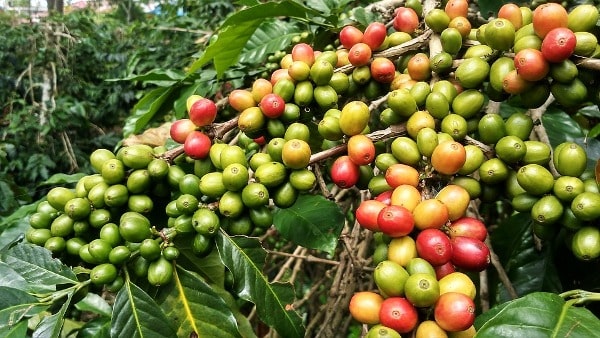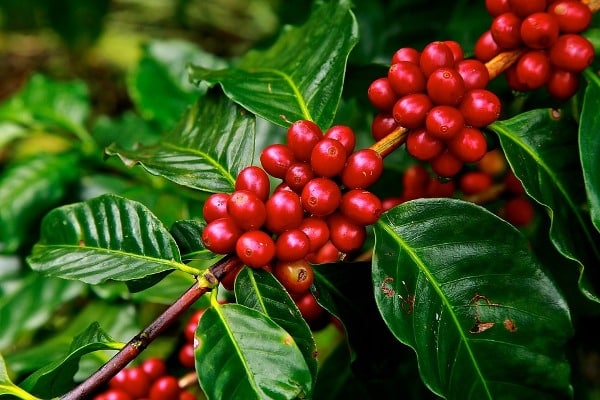Introduction to Coffee Farming Project Report
The following information is for people who are looking for Coffee Farming Project Report and Cultivation Methods.
Coffee bean or simply coffee is the seed obtained from the berry of a plant belonging to the Coffea species. This species is native to tropical Africa, Madagascar, Comoros, Mauritius and Reunion islands. Coffee beans are roasted, ground and brewed with near boiling water so as to produce a beverage called coffee. Coffee is expected to contain caffeine content and is dark in colour. The ground coffee powder is bitter to taste and slightly acidic in nature. The coffee plant is considered to be a woody perennial and evergreen plant. Coffee is believed to be the most important cash crop of the tropics and is nicknamed as ‘Islamic milk’ or ‘sage’s milk’. This coffee farming project report outlines in detail the farming procedures and also discusses the estimated investment, related profits, etc. for coffee plantation in one hectare of land.
Scope and importance
Indian coffee production accounts for almost 4.5% of the total coffee production in the world. Coffee exports from India earn a foreign exchange of 4000 crore Rs and have gained high importance in the international market. Three Indian states cultivate coffee predominantly; they are Karnataka, Tamil Nadu and Kerala. In India coffee is marketed through a statutory organization called the Coffee Board. Coffee cultivation in India is done under a multi-layered canopy of forest trees or other crops and these coffee plantations are a home to varied forms of flora and fauna. There are difficulties in production and marketing of coffee; since this crop is very important to the economy of its producing states, there are efforts being made to increase the area under coffee cultivation, provide financial support to the farmers, bring up new channels for marketing their produce and help them solve other farm related issues.

Coffee plant and its properties
As already known, coffee is a tropical plant growing to a height of 10 to 15 m in the wild. For easier harvesting, this plant is allowed to grow only to a height of 3 m. The production life time of a coffee plant is around 15 to 20 years.
The leaves of the plant are elliptical in shape, dark green in colour and shiny, waxy in texture. The average length of the leaves is estimated to be around 15 to 24 cm. The leaves on the underside are marked by small cavities. The leaves on the suckers and the trunks are crossed and on the remaining branches, they are on the same plane.
The flowers of the plant are white or pinkish in colour with very nice fragrance. They are arranged in the form of 3 to 16 glomerules grouped together in the axils of the leaves. The flowers wither off within a few hours of blooming. These are self fertile and produce fruits without pollination.
The roots of the plant penetrate to a depth of 2.5 to 4 m, and can spread to a length of 2 to 2.5 m.
The fruit of the coffee plant is oval in shape and resemble olives. The fruit turns red upon ripening and consists of two seeds. The plants bear fruits and flowers at least two to three times in a year and ripen in 6 to 7 months. The ripening period may vary for different plantations depending on the external environmental conditions of the area. Fruit is the most essential part of the plant.
Cultivars / Varieties of Coffee
There are more than 70 different varieties of coffee plants found all over the world, but only two major species are considered for cultivation and they are:
Coffea Arabica or the Arabica Coffee
- This variety constitutes around three-quarters of the total production.
- Originated in Arabia.
- Suitable for growing in areas with rich minerals.
- It has sub-varieties like Moka, Mara-gogipe, San Ramon, Colomnaris and Bourbon.
- Has low caffeine content.
- This variety beans are elongated and are greenish-blue in colour.
- The taste of coffee is sharp, but flavoury.
- The sub-species of this variety coffee differ in size, colour, shape, climatic needs, yield patterns and product quality.
Coffea Canephora or the Robusta Coffee
- It is considered superior to the previous variety.
- The plant grows to a height of 12 m.
- Suitable for cultivation at altitudes up to 600 m.
- Resistant to pests and diseases.
- Originated in Congo, Africa.
- Only 25% of this variety contributes to the total production.
- Has a higher caffeine content that Arabica coffee.
- Beans are small and have strong character.
- The color of the beans is brownish yellow.
Cultivation of Coffee requirements

Climate and soil specifications
Temperature is considered to be one of the most important factors for coffee cultivation. The average temperature range for coffee cultivation is estimated to be around 12 to 26˚C. Beyond these temperatures, coffee cultivation is possible but too much variation could be harmful for the bush. Extremely low temperature can stunt the growth of coffee plants. The plants need a short cold period, otherwise the growth, flowering, fruit bearing; ripening and yield is adversely affected. High summer temperature is mostly considered good for fruit development and ripening. Frost and wind are not suitable for the plants, therefore planting is done on ridges to overcome the frost effect and windbreaks minimize the wind effect on the plants.
Plants are intolerant to water shortage and a minimum precipitation of about 1500 mm a year is definitely needed for plant growth. It is advisable to grow coffee in areas having good spring rainfall because it induces flowering in the coffee plants. There should be preferably dry winter in the area of coffee plantations.
The most suitable type of soil for coffee cultivation is sandy-loam, but the plants are known to grow in any fertile soil provided the weather in the area is suitable. The properties of the soil for coffee cultivation are such that it should be deep permeable; good textured with rich organic matter and should have the capacity of proper water balancing. The soil should have only 15 to 35% of clay content with a pH of about 5 to 6. The most suitable area for coffee plantations is where natural forests occur.
Propagation methods
Coffee plants can either be propagated through seeds or cuttings. The true nature of the plant is developed only when they are propagated through seeds and since Arabica variety is self pollinating, it is grown through seeds. Seeds are initially raised in a nursery and then transplanted over to the main farming area. These seeds should be obtained from organic estates or blocks to have high yielding capacity. In the nursery the seeds are grown on beds with 1 m width and 15 cm high from the ground level. Selected seeds are sown during December or January such that the flat side of the seed faces the soil for easy germination and root development. Seeds probably start germinating in about 40-45 days and attain the button stage. The seedlings can now be transplanted into a secondary nursery of poly bags.
Coffee plants with high yielding capacity and high disease resistance can be selected to carry out the vegetative propagation process.
Land preparation and planting
The area to be used as coffee farm should be free from rocks, debris and other vegetative material. Ploughing and harrowing twice in a week can control weed growth. The soil sample should be sent for analysis so as to determine the type of amendments that could be made before planting. Testing the soil before cultivation can give the farmer information about the type of fertilizers and nutrients required for the crops to grow well. A seed bed is prepared for planting the seedlings. Several months before planting proper fertilizers should be supplied to the soil during ploughing and disking. If the land can’t be ploughed then pits are created for planting the seedlings without damaging their taproots.
The spacing between the plants is decided depending on various factors such as variety, topography, the fertility of the soil and management practices. Good varieties of coffee plants grown in rich soil and good climatic conditions as generally spaced wider. For the Arabica variety recommended spacing is around 2 x 3 m and for Robusta it is 3 x 3 m spacing. The layout is generally oriented towards east-west direction.
The seedlings are planted into the main area during the spring or early monsoon time. The recommended row spacing is around 15 to 20 cm. The seedling used for transplantation should be 6 months old with about 20 cm of growth. The dimensions of the pit into which they are planted should be about 50 x 50 x 50 cm.
Manure and fertilizer requirements
Coffee plants need high nutrient content. The manure and fertilizer requirement may vary for different plantations depending on the fertility of the soils and climate of the region. Generally fertilizers are applied 4 to 8 weeks after planting (during August/ September); by choosing the right fertilizers after the analysis of soil samples. Nitrogen, potassium, zinc and boron are exclusively needed for coffee plants.
For the Arabica variety fertilizers are applied two times; once as pre blossom and the other as post blossom. The ratio of N: P: K during the 1st year of planting is 15: 10: 15, 2nd and 3rd year is 20: 10: 20, 4th year is 30: 20: 30 and above 5 years it is around 40: 30: 40.
Similarly, for Robusta variety with less than 1 tonne /ha crop only pre-blossom application of fertilizers is done in the ratio N: P: K as 40: 30: 40. For 1 tonne /ha and above crops two applications are recommended pre blossom and post blossom N: P: K as 40: 30: 40.
During land preparation at the nursery stage soil, FYM and sand in the ratio of 6: 2: 1 are mixed and filled into the polythene bags. The main area pits are filled with 500 g of rock phosphate per pit along with top soil before planting.
Irrigation needs
When there is no adequate rainfall, it should be supplemented with irrigation. Before planting light irrigation around 50 mm is applied and after planting around 25 mm of irrigation is applied. Irrigation should be given after every 10 days to keep the soil moist, but not too wet. Too much irrigation can lead to fungal diseases. The coffee plants should be irrigated two times in a week during summer and only once in a week during winter. Depending on the dimensions of the farm and the requirement of water, there can be different ways by which irrigation can be supplied such as hose and basin, drag-hose sprinkler, drip irrigation, micro jet irrigation etc.
Young coffee plants need 5 to 10 litres of water per plant in a week. Soil should be tested by hand for the level of moisture content and then the next watering cycle should be initiated.
Pest and disease control
There are innumerable pests that attack the coffee plants, of which some common pests that infest the plants are white stem borer, antestia stink bug, leaf minor, mealy bug, black coffee stem borer, gray coffee snout beetle, coffee berry moth, variegated coffee bug, twig borer, nematodes, green scale etc. To control these bugs, registered chemical insecticides are recommended. Some organic ways of treating the pests are by spraying neem kernel extract or by the applying neem cake during soil preparation.
Some common diseases occurring in these plants are coffee leaf rust, coffee berry disease, tracheomycosis wilt, American leaf spot, root rot, rosellinia bunodes, armillaria mellea, cercospora spot etc. Only registered chemicals under proper recommendation should be administered to the plants. Cultural methods and farm management can prevent most of the diseases; else 1% of Bordeaux mixture should be sprayed to keep the plantation area free from minor diseases.
Intercultural Practices

The cultural practices for Arabica and Robusta are different and are carried out in different sections and months. Some common cultural practices required for proper maintenance of the farm are discussed here:
Pruning
The coffee plants start producing new shoots after the summer showers and this is considered the right time to prune or thin the plants. By thinning the unwanted shoots, strength is indirectly given to the main stem. Pruning of dried branches or unwanted twigs facilitates the supply of air and sunlight to all the parts of the bushes. Proper pruning can help the plant achieve a desired shape. Some coffee plantations prune the plants after harvest. It is always recommended to practice light pruning for the removal of unproductive wood, criss-cross branches, pest or disease infested areas from the plants
Shade tree planting
Shade trees like Indian fig, atti, bili basari, mallegargatti, rosewood, jack and gandagarige can be planted within the coffee farms. Silver oak can also be used as a shade tree, but should always be planted with other shade trees because it alone increases the farm temperature to a greater level. The leaf litter of the silver oak tree doesn’t decompose faster. The shade trees should be planted at a distance of 12 to 15 m around the farm area. Places those are prone to strong winds need shade trees like silver oak and silk cotton to be planted at the boundary of the coffee plantation estate.
The coffee plants are also protected by a lower canopy of shade trees called the Dadap during the drought period. The dadap planting should be done in the months of June or July when sufficient moisture is available in the soil for the stalks to root. The dadap stalks used for planting should have a minimum height of 1 to 1.5 m with a girth of 5 to 6 cm. Sufficient fertilizers are to be supplied to these plants for better root and plant development.
Weeding
Weeds in the coffee farm after the post monsoon period tend to use up all the soil moisture and nutrients from the soil. Therefore, it is highly important to control the weeds in the farm area with young plantations. In the newly established farms, slash weeding should be done to remove the weeds at least 3 to 4 times in a year. Before planting in the new farms, cover digging is done to a depth of 9 inches to remove all the unnecessary waste from the land. After planting the coffee seedlings, the intermediate space is utilized to grow green manure crops like legumes, beans, pigeon peas, sweet potato and vegetables so that weeds are under control. Mulching the base of the plants with shade tree leaf litter and weed slashings could also be beneficial for smothering the weeds.
Mid-monsoon manuring
It is believed that the nitrogen nutrient is lost very fast during the monsoon due to leaching so the nitrogen supplement is given to help the plant develop new shoots during this time. Around 58 kgs of nitrogen is provided per hectare during the monsoon break. Supplying nitrogen fertilizer during this period also controls the berry drop problem.
Gleaning
The process of collecting all the fallen berries from the ground after the entire harvest process to control the infestation of CBB is called gleaning. These fallen berries are dried separately and not mixed with the other berries.
Harvesting
The coffee fruits mature during the period from May to October and the maturity is indicated by the change in colour of berries to red. They also become soft upon ripening. Generally the coffee berries are ready for harvest after 8 to 9 months of flowering. Harvesting in coffee can be done in four different ways.
The first method is called stripping where all the berries, flowers, unripe fruits etc. are removed by hand. The second way of harvesting the plants is by using a comb to brush the trees. In this method only the ripe berries are removed, leaving the unripe berries for the next harvest.
The third way of harvesting is by using mechanical equipment called vibrator. This is fixed to the trunk of the tree and it shakes the ripe berries such that they fall to the ground and can be collected easily.
The fourth method is considered very expensive because too much labor is involved in picking the berries by hand at regular intervals of time. The berries are picked from the center using both hands.
Post Harvest management
Processing the picked berries to obtain the coffee beans and further processing them to be sold in the market involves a series of steps like drying, grading, packing, storing etc.
- The coffee fruits that are picked should be dried initially. They can be dried under shade, direct sun or by using mechanical hot air drying. 13 to 15% moisture from the berries is removed by drying. Drying the berries under the sun is considered cheap and the product obtained is of higher quality. This method needs much labour, space and time. For drying, the berries are laid with a thickness of 2.5 cm and should be turned every hour.
- Grading of berries is done according to their size and shape. A rotating sieve separates the dry, green and hulled coffee beans. A three dimensional grading is done for flat beans depending on their width, thickness and length.
- The coffee should be packed firmly otherwise pressurized water will break the coffee apart while brewing and doesn’t permeate into it evenly. The packing should be free of aluminium such that it becomes highly compatible with the environment.
- The product is considered to be hygroscopic in nature i.e. it absorbs moisture from the air. Both dry and wet processing methods make the coffee less hygroscopic, but it should be stored in well spaced, ventilated and dry areas.
Loans and subsidies for Coffee cultivation
The Coffee Board of India under the Ministry of Commerce and Industry, Government of India has many schemes to support the coffee farmers in India. The assistance is provided in different forms such as farm development in traditional and non-traditional areas, transit assistance during exports, insurance for rainfall, development of market, support the children of the laborers, coffee estate mechanization etc. The detailed information regarding the type of assistance and percentage of subsidy related to it can be obtained from the official website of the coffee board of India.
Cost and profit analysis of Coffee farming/ Economics of Coffee cultivation/Coffee Farming Project Report

The investment details for one hectare of land are calculated with approximate values of the available materials. It should be noted that these values are not permanent and may vary depending on the size of the structure, their availability and location. The estimation doesn’t involve land rent, transport, watch and ward, depreciation charges, etc. All these have to be considered accordingly during the real deployment of the structure.
Rate of labour per manday: Rs 250.
Cost of planting material for coffee: Rs 10 per plant.
Fixed investment
| Particulars | Investment in Rs |
| Pump set, house and well establishment | 45,000.00 |
| Cost of Sprinklers and sprayers | 20,000.00 |
| Cost of fencing the farm | 45,000.00 |
| Cost of labour for land preparation @ 57.88 mandays | 14,470.00 |
| Cost of labour for pit preparation and planting @ 77.45 mandays | 19,363.00 |
| Labour for planting shade trees @ 22.76 mandays | 5690.00 |
| Cost of planting material @ 2187 plants | 21,870.00 |
| Cost of shade tree material @ 875 plants | 5000.00 |
| Total investment (fixed) | 1,76,393.00 |
Maintenance cost of the coffee farm during the bearing period (variable costs)
| Particulars | Investment in Rs |
| Cost of 6.20 tonnes of manure @ Rs 1000/ton | 6200.00 |
| Cost of 12.20 quintals of fertilizers | 12,200.00 |
| Cost of 20 kgs of PP chemicals | 4000.00 |
| 481.70 kg of lime | 2000.00 |
| Cost of 1 litre of weedicide | 300.00 |
| Total costs | 24,700.00 |
| Labour costs during bearing period | Investment in Rs |
| For manure and fertilizer application @ 31.25 mandays | 7900.00 |
| 10 mandays for irrigation | 2500.00 |
| 21.25 mandays for weeding | 5500.00 |
| 15 mandays for PPC application | 3750.00 |
| 21.25 mandays for pruning | 5500.00 |
| 31.88 mandays for shade regulation | 7800.00 |
| 75 mandays for soil and land management | 18,750.00 |
| 96.25 mandays for harvest and processing | 24,000.00 |
| Other miscellaneous costs | 10,000.00 |
| Total cost | 85,700.00 |
Sale price of coffee beans per kg: Rs 120 (average price).
Yield of beans per hectare of land: 3000 kgs (average).
Total income from the farm: Rs 3, 60,000.
Profit from the farm in the 5th year of planting is around: Rs 2, 49,600.
It is important to note that the coffee plantations have to be maintained during the gestation period for about 3 or 4 years until the bearing stage. The minimum charges for gestation periods are estimated to be around 50 to 80 thousand rupees and are mainly required for manure, labour, fertilizers, irrigation, electricity etc.
Read: Cinnamon Growing Information.
Hi
Would it be possible to grow coffee plant in Gujarat? Where in summer the temperature is around 40°C.
If your place belong to high altitude region(800-1200mtr) the temperature doesn’t matter, but in Gujarat there my little chance get this kind of altitude
Is it possible to get the project report of the coffee farming project
I am from keonjhar dist of ODISHA,the altitude of my district is about 600 will farming of Coffey is possible here. Also what about the market, where to sell it? Please reply. Thanks
Please send me coffe farming project
Can you please suggest best variety of coffee plants, for cultivation near Bangalore on kanakapura road.
MSL 780.
ph of water 7.
Red soil.
kindly advice .
Thank you